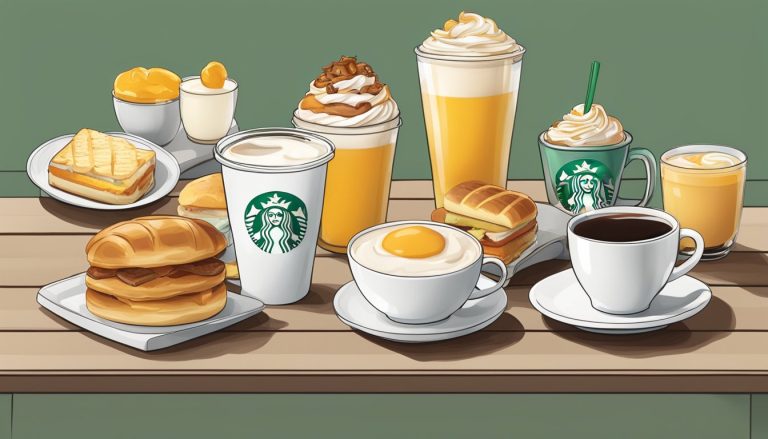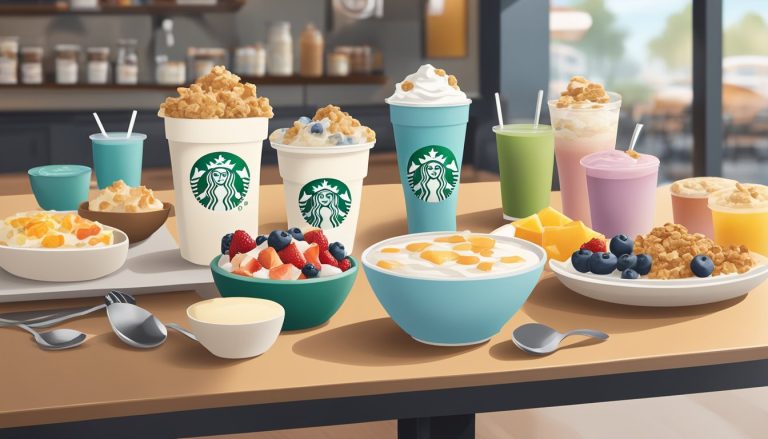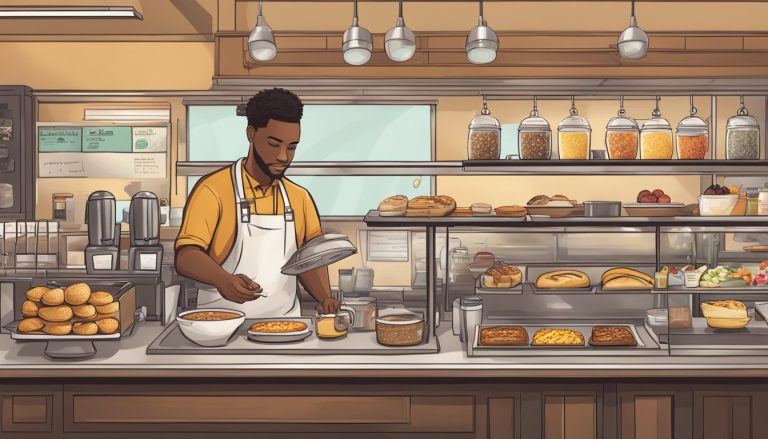Starbucks, the global coffee giant, has a rich history that began in Seattle’s bustling Pike Place Market in 1971. Originally a purveyor of high-quality coffee beans and equipment, the company’s journey into breakfast offerings came years later as part of its expansion strategy.
Starbucks introduced its first breakfast items in the late 1980s, starting with pastries to complement its coffee selections. This move was a response to customer demand and a way to increase sales during morning hours. As the coffee industry evolved, so did Starbucks’ breakfast menu, gradually incorporating more substantial options to cater to a growing base of on-the-go consumers.
The company’s breakfast offerings have since become a cornerstone of its business model, contributing significantly to its revenue and solidifying its position as a go-to morning destination for millions worldwide. From simple pastries to more elaborate breakfast sandwiches and wraps, Starbucks has continually innovated its morning fare to meet changing consumer preferences and dietary trends.
The Birth of Starbucks and Its Founding Fathers

Starbucks emerged in 1971 from the bustling Pike Place Market in Seattle. Three visionary entrepreneurs – Jerry Baldwin, Zev Siegl, and Gordon Bowker – laid the foundation for what would become a global coffee empire.
The Conceptualization in Seattle’s Pike Place Market
The first Starbucks store opened its doors at 2000 Western Avenue in Seattle’s historic Pike Place Market. Initially, the shop focused on selling high-quality coffee beans, tea, and spices.
The founders drew inspiration from Alfred Peet, a coffee roasting entrepreneur. They sourced arabica coffee beans from various parts of the world and roasted them on-site.
This commitment to quality and freshness set Starbucks apart from the beginning. The store’s name, inspired by Moby-Dick, reflected the founders’ love of coffee and Seattle’s maritime history.
Profiles: Jerry Baldwin, Zev Siegl, and Gordon Bowker
Jerry Baldwin, an English teacher, brought his passion for fine coffee to the venture. Zev Siegl, a history teacher, contributed his organizational skills and business acumen.
Gordon Bowker, a writer, completed the trio with his creative vision. Together, they shared a love for coffee and a desire to introduce Seattle to premium, fresh-roasted coffee beans.
The founders’ diverse backgrounds complemented each other, creating a strong foundation for the company. Their combined expertise in education, business, and creativity proved crucial in shaping Starbucks’ early identity and success.
Early Growth and Product Expansion

Starbucks’ rapid expansion in the 1990s came with an evolution of its menu and store experience. The company introduced new coffee drinks and food items while refining its iconic atmosphere.
Starbucks’ Initial Offerings and Store Experience
Starbucks started with a focus on high-quality, fresh-roasted coffee beans. Early stores offered a limited selection of brewed coffee and espresso drinks. The mermaid logo, inspired by a 16th-century Norse woodcut, became a recognizable symbol of the brand. Stores featured a warm, inviting atmosphere with wood accents and the aroma of freshly ground coffee.
As Starbucks grew, it emphasized barista training to ensure consistent quality across locations. The company introduced larger sizes and customization options for drinks. This approach helped create a unique “Starbucks Experience” that set it apart from traditional cafes.
Key Developments in Coffee and Food Selection
In the mid-1990s, Starbucks significantly expanded its menu. The introduction of the Frappuccino in 1995 marked a major milestone, attracting new customers with its sweet, icy blend. Flavored syrups and seasonal offerings like the Pumpkin Spice Latte followed, broadening the drink selection.
Food options grew from basic pastries to include sandwiches, salads, and snack boxes. Starbucks partnered with local bakeries in some markets to offer fresh-baked goods. The company also began selling whole bean coffee and brewing equipment for home use.
By 2000, Starbucks had over 3,000 locations and a diverse menu of coffee drinks, teas, and food items. This expansion helped fuel the company’s rapid growth and global expansion in the following years.
Howard Schultz and the Coffee Culture Revolution

Howard Schultz transformed Starbucks from a small coffee bean retailer into a global coffeehouse empire. His vision of creating a “third place” between work and home revolutionized coffee culture in America and beyond.
The Entry of Howard Schultz into Starbucks
Howard Schultz joined Starbucks in 1982 as Director of Retail Operations and Marketing. At the time, Starbucks was a local Seattle company with just a few stores selling coffee beans.
Schultz’s pivotal moment came during a 1983 trip to Italy. He was captivated by Milan’s vibrant coffeehouse scene, where espresso bars served as community hubs.
This experience inspired Schultz to reimagine Starbucks as more than just a coffee retailer. He envisioned bringing Italian coffee culture to America.
Creating the Starbucks Coffeehouse Model
Schultz’s idea was to transform Starbucks into a coffeehouse chain. He wanted to create a welcoming “third place” for customers to gather and enjoy premium coffee.
Initially, Starbucks’ owners were skeptical. They resisted changing their successful coffee bean business model.
Undeterred, Schultz left Starbucks in 1985 to start his own coffee shop chain called Il Giornale. He focused on serving espresso drinks and creating a European-style coffeehouse atmosphere.
Il Giornale’s success proved the viability of Schultz’s concept. It set the stage for his return to Starbucks and the company’s transformation.
Founding the Starbucks Corporation
In 1987, Schultz acquired Starbucks with the help of local investors. He became CEO and began implementing his coffeehouse vision on a larger scale.
Schultz introduced the espresso bar concept to existing Starbucks locations. He emphasized quality, ambiance, and customer service to differentiate Starbucks from competitors.
The company expanded rapidly, opening new stores across the U.S. and later internationally. Schultz’s focus on employee welfare, including health benefits for part-time workers, helped attract and retain talent.
By the mid-1990s, Starbucks had become a household name. Schultz’s vision had not only transformed Starbucks but had also revolutionized American coffee culture.
National and International Expansion

Starbucks’ journey from a single Seattle store to a global coffee empire involved strategic growth across the United States and international markets. The company’s expansion transformed it into a household name and coffee industry leader.
Spread Across the United States
Starbucks began its national expansion in the 1980s, moving beyond Seattle to other major U.S. cities. Chicago became an early target, with stores opening there in 1987. The company quickly expanded to California and the East Coast.
By 1990, Starbucks had 84 stores across the Northwest and Midwest. New York City saw its first Starbucks in 1994, marking a significant milestone in the company’s growth. The rapid expansion continued throughout the 1990s.
Starbucks’ store count reached 1,000 by 1996, and 2,000 by 1998. This aggressive growth strategy helped Starbucks capture a significant market share in the U.S. coffee industry.
Entering the Global Market
Starbucks’ international expansion began in 1996 with its first overseas store in Tokyo, Japan. This move marked the beginning of Starbucks’ transformation into a global brand.
Vancouver, Canada, became the first international city outside of Asia to welcome Starbucks in 1987. The company then set its sights on Europe, opening stores in the United Kingdom in 1998.
China, now Starbucks’ second-largest market, saw its first store in 1999 in Beijing. The company’s expansion in China has been particularly rapid, with over 4,000 stores by 2020.
By 2000, Starbucks had established a presence in 20 countries. This global reach solidified its position as a coffee giant and set the stage for continued international growth in the 21st century.
Evolution of Starbucks’ Menu and Services

Starbucks has continually expanded its offerings beyond coffee, embracing new beverages and technologies to enhance the customer experience. This evolution reflects the company’s commitment to innovation and meeting changing consumer preferences.
Beyond Coffee: The Inclusion of Diverse Beverages
In 1995, Starbucks introduced the Frappuccino, a blended ice beverage that quickly became a fan favorite. This marked the beginning of Starbucks’ expansion into non-coffee drinks.
In 1999, Starbucks acquired Tazo Tea Company, broadening its tea selection. The company further diversified its menu with the launch of smoothies in 2008, featuring Greek yogurt and cold-pressed juices.
Starbucks also ventured into food offerings, introducing breakfast sandwiches in 2003 and expanding its food menu to include pastries, salads, and snacks.
Innovation in Customer Experience and Ordering
Starbucks launched its Rewards program in 2009, allowing customers to earn points for purchases and redeem them for free drinks and food items. This loyalty program has since become a cornerstone of Starbucks’ customer engagement strategy.
In 2011, Starbucks released its mobile app, enabling customers to pay for orders and track rewards directly from their smartphones. The app later introduced mobile ordering and payment features, allowing customers to skip lines by ordering ahead.
Drive-thru service expanded significantly, with over 60% of new Starbucks locations including this option by 2020. This innovation proved crucial during the COVID-19 pandemic, providing a safe and convenient way for customers to get their favorite beverages.
Strategic Moves and Partnerships

Starbucks expanded its reach and product offerings through key acquisitions, alliances, and joint ventures. These strategic moves positioned the company for growth in new markets and segments.
Acquisitions and Alliances
Starbucks acquired Peet’s Coffee in 1984, gaining valuable coffee expertise and supply chain connections. The company later sold Peet’s in 2001 to focus on its core brand. In 1999, Starbucks purchased Tazo Tea, diversifying its beverage portfolio.
The acquisition of Seattle Coffee Company in 2003 added Seattle’s Best Coffee and Torrefazione Italia to Starbucks’ lineup. This move expanded Starbucks’ presence in grocery and food service channels.
Starbucks formed an alliance with Kraft Foods in 1998 to distribute whole bean and ground coffee to retail stores. The partnership ended in 2011 after a legal dispute.
Joint Ventures and Diversification
Starbucks entered a joint venture with PepsiCo in 1994 to produce and distribute bottled Frappuccinos. This partnership expanded Starbucks’ reach into retail channels beyond its cafes.
In 1995, Starbucks created a joint venture with Dreyer’s Grand Ice Cream to develop and market Starbucks Ice Cream. The product line was later discontinued in 2008.
Starbucks formed partnerships with airlines like United Airlines to serve its coffee in-flight. This move increased brand exposure to travelers.
A brief alliance with Kozmo.com in 2000 allowed Starbucks to experiment with online ordering and delivery services, though the partnership was short-lived.
Challenges in the Coffee Industry

The coffee industry faces significant hurdles in maintaining growth and sustainability. Market competition and environmental concerns shape how major players like Starbucks operate and innovate.
Market Competition and Starbucks’ Response
Coffee chains constantly vie for consumer attention and loyalty. Starbucks, as a market leader, faces stiff competition from both established brands and local cafes. McDonald’s entry into the premium coffee market with McCafé forced Starbucks to reassess its strategies.
In response, Starbucks enhanced its product offerings and customer experience. The company introduced new beverages, expanded food options, and improved its mobile app for easier ordering. These moves aimed to differentiate Starbucks from competitors and maintain its market position.
Starbucks also focused on creating a unique “third place” atmosphere in its stores. This strategy emphasized human connection and community, setting it apart from fast-food coffee options.
Sustainability Efforts Amidst Environmental Concerns
Climate change poses a significant threat to coffee production worldwide. Coffee chains face pressure to adopt sustainable practices and reduce their environmental impact.
Starbucks implemented several initiatives to address these concerns:
- Ethically sourcing coffee beans
- Investing in farmer support centers
- Developing eco-friendly packaging
The company set ambitious goals to reduce waste and carbon emissions. It aims to cut its carbon footprint by 50% by 2030.
These efforts not only address environmental issues but also appeal to environmentally conscious consumers. Sustainability has become a key factor in brand perception and customer loyalty in the coffee industry.
Starbucks’ Impact and Cultural Significance
Starbucks transformed coffee consumption globally and became a ubiquitous symbol of modern urban life. The company’s influence extends beyond beverages, shaping social habits and corporate practices worldwide.
Influence on Global Coffee Culture
Starbucks popularized specialty coffee drinks and created a “third place” between home and work. The company introduced terms like “latte” and “frappuccino” into everyday vocabulary. Starbucks’ aesthetic – green logo, cozy interiors, and personalized cups – became instantly recognizable worldwide.
In the Philippines, Starbucks’ entry in 1997 sparked a coffee shop boom. The United Kingdom saw similar growth after Starbucks acquired the Seattle Coffee Company in 1998. These expansions demonstrated the brand’s ability to adapt to local tastes while maintaining its core identity.
Starbucks’ success inspired countless imitators, elevating coffee quality standards globally. The company’s emphasis on ethically sourced beans influenced industry practices.
The Company’s Contributions to Society
Starbucks pioneered corporate social responsibility in the fast-food industry. The company offers health insurance to part-time employees, an unusual practice in food service. Its College Achievement Plan helps U.S. employees earn online bachelor’s degrees.
As a global strategist, Starbucks promotes environmental sustainability. The company aims to cut its carbon footprint and water use while increasing recycling efforts. Starbucks also supports coffee-growing communities through its C.A.F.E. Practices program.
The Starbucks Foundation funds local charities and youth programs worldwide. In times of crisis, Starbucks stores often serve as community gathering points, offering free Wi-Fi and charging stations.
Financial Growth and Corporate Status

Starbucks transformed from a local Seattle coffee shop to a global powerhouse through strategic expansion and financial success. The company’s rapid growth led to its public listing and dominant market position in the coffee industry.
Starbucks in Stock Markets and Financial Success
Starbucks went public in 1992, listing on the NASDAQ under the ticker SBUX. The IPO raised $25 million, fueling further expansion. By 1996, the company had over 1,000 locations.
Starbucks’ revenue grew exponentially, reaching $26.5 billion in fiscal year 2019. Net income also soared, hitting $3.6 billion that year. The company’s market capitalization exceeded $100 billion by 2020.
Store count increased dramatically. Starbucks operated over 30,000 locations globally by 2019. This rapid expansion solidified its position as the world’s largest coffee chain.
The Future of Starbucks in the Coffee Business
Starbucks aims to maintain its market leadership through innovation and global growth. The company plans to reach 55,000 stores by 2030, focusing on China and other emerging markets.
Digital initiatives, like mobile ordering and delivery partnerships, are key to Starbucks’ future strategy. These efforts seek to enhance customer convenience and loyalty.
Sustainability is another focus area. Starbucks has committed to reducing its environmental impact through ethical sourcing and waste reduction programs.
Competition in the global coffee market remains fierce. Starbucks faces challenges from both established chains and local artisanal coffee shops. Adapting to changing consumer preferences will be crucial for continued success.




